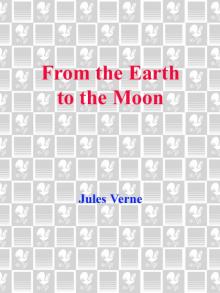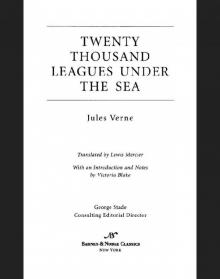- Home
- Jules Verne
Journey to the Center of the Earth (Barnes & Noble Classics Series) Page 2
Journey to the Center of the Earth (Barnes & Noble Classics Series) Read online
Page 2
1899 Verne’s Le testament d’un excentrique (The Will of an Eccentric ) deals with the oil industry’s ravages of the environment.
1905 Leaving a drawer filled with manuscripts, and with his family gathered at his bedside, Jules Verne dies of complications
from diabetes. He is buried in Madeleine Cemetery in Amiens. His posthumously published novels, altered considerably by his son, Michel, remain a source of scholarly debate and interest.
Introduction
Traveling to the center of the Earth would involve a downward trip of about 4,000 miles that would cut through the Earth’s crust and its mostly solid, rocky mantle into a liquid core of iron alloy, then end at a solid inner core of iron and nickel. Pressure and temperature would rise with increasing depth, and temperatures would reach about 10,300 degrees Fahrenheit at the Earth’s center—hardly a climate that many geo-tourists would enjoy! Much of this knowledge about the geophysical structure of the Earth was acquired in the course of the twentieth century, long after Jules Verne published Journey to the Center of the Earth. In 1864, when the book appeared, different hypotheses about the nature of the Earth competed with each other. Even then, though, in light of any of the contemporary scientific theories, a journey to the Earth’s core belonged to the realm of the fantastic. Why then did Verne, who was intensely interested in the science and technology of his day, choose this idea as the founding assumption of what was to become one of his most famous novels? And why is this journey undertaken not by a dreamer or a madman, but by a hard-core scientist, a professor of mineralogy and geology who is thoroughly familiar with the scientific debates of his time?
For a reader who first encounters Journey to the Center of the Earth at the beginning of the twenty-first century, the enthusiasm of Professor Otto Lidenbrock, his nephew Axel, and even Lidenbrock’s goddaughter Graüben for mineralogical specimens and geological theories may seem nothing short of eccentric. After Alfred Wegener’s theory of continental drift—originally proposed in the 1920s—had been generally accepted in the 1960s, geology disappeared from public awareness as a science that could bring about exciting new discoveries and theories. But in the middle of the nineteenth century, geology was a brand-new branch of knowledge rife with the opposing theories and opinions of some of the best minds of the day. Far from being an arcane branch of scientific knowledge of mostly academic interest, it touched upon the most basic questions of the origin of life and human beings and the nature of the very soil they walk upon. Not just scholars but public and religious authorities believed they had a vital stake in the outcome of geological controversies.
As a scientific discipline, geology had in fact only come into being in the first half of the nineteenth century. Before that, mineralogists had been just about the only scientists to study the inanimate environment, conducting their investigation of the Earth most frequently in the context of French and German mining schools. Their study consisted of a mix of natural philosophy, theology, and the beginnings of empirical observation, without the benefit of an established academic framework. Abraham Gottlob Werner, a German professor at the Mining School of Freiberg in the late eighteenth century, combined the study of rock formations with the biblical account of Genesis. The Scottish naturalist, chemist, and geologist James Hutton opposed Werner’s theories and grounded his own account of the development of the Earth on observable processes and on the principle of unifbrmitarianism—that is, the idea that the processes that had gone into the shaping of the Earth over immensely long periods of time had not fundamentally changed and could still account for geological development. Hutton’s work was followed by that of Scottish geologist Charles Lyell, whose classic book Principles of Geology, published in 1830, laid down the foundations of a new, empirically based science of the Earth.
But the Earth is so vast and all-encompassing that it often appeared complicated to infer its general operating principles from the processes observable in one particular place. Indeed, huge areas of geology—the 70 percent of the Earth’s surface that is under water, as well as its interior—are simply inaccessible to direct human observation. (Lyell once joked that an amphibious observer who could inhabit both land and sea would be a more suitable geologist than a human being.) For these reasons, divergent theories about the nature of the Earth continued to rage throughout the nineteenth century. While some scholars argued that the interior of the Earth had to be mostly liquid, with the solid ground a mere thin crust not unlike ice on lake water, others replied that on mathematical grounds the Earth could not be anything but for the most part solid. The age of the Earth was similarly subject to vastly divergent estimations, and this issue became part of the violent controversy over Darwin’s theory of evolution in the 1850s and 1860s. Biological evolution occurs over immense periods of time, and in general, the development of the physical structure of the Earth over hundreds of thousands or even millions of years contradicts creationist accounts of a much shorter time span for the origins of the Earth.
In Verne’s day, therefore, geological theories about the origin and gradual shaping of the Earth, along with biological insights into the evolution of life, were what genetic engineering and nanotechnology are for us today: innovative and exciting areas of scientific research that have a profound bearing on the way we think about our own identity and experience our everyday lives. Verne’s familiarity with these debates shows up in every chapter of Journey to the Center of the Earth, which abounds in references to the leading scientific minds of his day, from naturalists and geologists such as Georges Cuvier to explorers such as Alexander von Humboldt and archaeologists such as Jacques Boucher de Perthes. Caught up in the evolving plot, a contemporary reader’s attention might easily slide over such references unawares. But their presence is the equivalent of mentions of James Watson and Francis Crick, Stephen Hawking, or Bill Gates in a novel written today.
Verne’s editor, Pierre-Jules Hetzel, claimed in a preface he wrote in 1866—just two years after the first publication of Journey to the Center of the Earth—that Verne’s novels were finally making a place for science in the domain of literature, and that Verne would eventually present all the knowledge of geography, geology, physics, and astronomy that modern science had accumulated. Verne himself once remarked to the French novelist Alexandre Dumas père, “Just as you are the great chronicler of history, I shall become the chronicler of geography.” It is not hard to see why an integration of scientific knowledge with compelling literary characters and plots would have proved an attractive mix both to the audience of Verne’s own day and those of subsequent periods: It combines the heady excitement of techno-scientific innovation with the pleasures of narrative storytelling and the free flight of the imagination.
This combination of science and fantasy may explain why Verne did not stick with the serious scientific theories of his day, but included marginal and controversial notions, too, such as that of a hollow Earth. English astronomer Edmund Halley proposed the idea that the Earth is hollow in the late seventeenth century. Swiss mathematician Leonhard Euler pursued the theory in the eighteenth century, as did Americans John Cleves Symmes and Jeremiah Reynolds and Scottish mathematician Sir John Leslie in the nineteenth century. (Axel alludes to Symmes in chapter XXIX, mistakenly identifying him as English rather than American.) Such theories influenced not only Verne, but also other writers and were sporadically revived until the early twentieth century. Edgar Allan Poe’s “Manuscript Found in a Bottle” and Narrative of Arthur Gordon Pym and Edgar Rice Burroughs’s At the Earth’s Core and Pellucidar are other examples. Yet by the time Verne published Journey to the Center of the Earth in 1864, hollow-Earth theories, while not entirely disproved, were not a central topic of debate among leading scientists.
Verne, famous for his extensive and meticulous note taking, was surely not unaware of this fact; what led him to use the idea of a hollow Earth as the foundation for his novel was no doubt the way in which the notion allowed him to tie scientific exploration into som
e of the oldest and most significant motifs of the Western literary tradition. On the surface, the plot of Journey to the Center of the Earth seems relatively straightforward: Lidenbrock and his nephew by sheer coincidence discover an ancient cryptogram that points to the bottom of an Icelandic volcano as the entryway to a passage that will eventually lead to the Earth’s core. Axel prefers the safety of life above ground and is reluctant to leave his fiancee, the professor’s goddaughter Graüben, but Lidenbrock becomes obsessed with the idea of retracing the steps of his illustrious predecessor, the sixteenth-century Icelandic scholar Arne Saknussemm, [...] to the center of the Earth. Lidenbrock, Axel, and their Icelandic guide Hans penetrate deep beneath the Earth’s crust, where they discover an alternative world of plants, animals, and even human beings that have long gone extinct on the surface, and return to ground level through another volcano. Although this plot may at first appear to be quite linear, it derives much of its narrative force from the way in which it invokes some of the founding stories of Western culture: the quest narrative, the descent to the underworld, and the initiatory voyage.
Professor Otto Lidenbrock is without any doubt a prime example of a hero on a quest so urgent that no one and nothing can stop it. His obstinacy in reaching the center of the Earth in spite of seemingly insurmountable obstacles puts him in the company of other literary figures whom we remember principally because of their overriding obsession with a single project: Jules Verne’s own Captain Nemo from Twenty Thousand Leagues under the Sea and Phileas Fogg from Around the World in Eighty Days provide the most obvious parallels, but one is also reminded of Captain Ahab, the protagonist of Herman Melville’s Moby-Dick. While these may well be more complex characters, Lidenbrock shares with them their stubborn single-mindedness, their iron determination, and the reckless imposition of their will on others who have no desire to take part in the pursuit but are dragged along regardless. Even seen through Axel’s reluctant eyes, however, Uncle Lidenbrock remains likable: His personal foibles, which Axel dwells on with a mix of gentle malice and affection, make him a more human figure than Nemo or Ahab, and the novel leaves us in no doubt that Lidenbrock is genuinely attached to his nephew and his ward Graüben—though his concern for them will never in the end deter him from his quest for knowledge.
While there is no doubt something cliched about this portrait of the fierce scientist with the warm heart under his crust of social brusqueness, it is Lidenbrock’s enthusiasm and determination in the pursuit of science that gives the novel much of its propulsive energy (as literary critics have pointed out, his temper is compared to volcanic eruptions and electric discharges long before his expedition actually encounters these phenomena in their literal shape). Yet it is curious that Lidenbrock’s scientific obsession is not presented as a quest for genuine innovation and original discovery, but rather as the repetition of a project that was already executed by someone else centuries earlier. The discovery of sixteenth-century scholar Arne Saknussemm’s manuscript certainly strikes a familiar note, as ancient books or maps and lost manuscripts written in secret codes play a crucial role in many nineteenth- and twentieth-century adventure romances. But here, the discovery turns the journey into the realm of the unknown into a simultaneous quest for the traces left by the historic predecessor; the search for the new combines with an attempt to reconnect with the past. These two time vectors in Lidenbrock’s voyage point to two quite different conceptions of history: on one hand, the idea of progress and its association with the increase of scientific knowledge, and on the other hand, the idea of a heroic past in which great men accomplished tasks that are difficult to repeat for ordinary individuals of the modern age. The ultimate outcome of Lidenbrock’s quest should be seen in light of this tension between different perspectives on the relationship of modern society to its past and future.
But whatever the philosophical implications of the professor’s expedition into the unknown may be, the reader’s attraction to following the journey lies above all in the abundance of physical detail that Verne provides. Whether the expedition’s goal is reached or not soon seems less important than the marvelous details that unfold before the travelers’ eyes. As the famous science-fiction writer Isaac Asimov has shrewdly noted, the scientific implausibility of humans penetrating deep into the Earth’s mantle despite increasing heat and pressure is compensated by Verne’s emphasis on precise details. From the meticulous attention paid to the tools and instruments the expedition requires to the narrator’s lovingly detailed descriptions of the physical features of each geological layer they encounter, Verne’s writing bewitches the reader with its insistence on the wonders of sheer materiality. He writes of the ingenuity of Ruhmkorff lamps with as much devotion as he describes the colored striations of marble in underground tunnels and the festive scintillations of light falling on thousands of bits of crystal and quartz embedded in walls and vaults of rock. Of course, this intense physical presence of nature is not always inviting for the characters: Steep vertical slopes, regions without a drop of water, heat, fierce storms, and darkness so absolute as to be almost palpable endanger the travelers, just as the primeval magnificence of the subterranean landscapes delights them. But whether it is splendid or menacing, the physicality of the environment in Verne’s novel holds the reader spellbound.
At the same time, Verne associates the materiality of the Earth with symbolic and metaphoric dimensions that may be quite familiar to the reader. Some of the most influential texts of the Western cultural tradition, from Homer’s Odyssey and Virgil’s Aeneid to Dante’s Divine Comedy, prominently feature the protagonist’s descent into the underworld, the realm of the dead, as an important part of his social and spiritual development. Usually, the point of this voyage to the underworld is to confront deceased individuals whom he used to know: parents, lovers, friends, or public figures from his own era, whose manner of death and afterlife are significant for his own course of life and contribute to a deeper understanding of his past and present. In Journey to the Center of the Earth, this confrontation with death and desolation starts long before the protagonists descend into the crater of the Snaefells volcano; fully a third of the novel is taken up with the description of their journey toward and across Iceland. This part of the trip takes the expedition through a magnificently portrayed wasteland of cold, solitude, and poverty where plants, animals, and humans are barely able to survive and shadowy lepers scurry away at the travelers’ approach. The impoverished Icelanders, portrayed as almost congenitally prone to silence and stolid acceptance of extreme adversity, sometimes seem to form part of an all-encompassing landscape of rock, ice, and steam more than of human society as we usually conceive it. All of these elements already suggest that the protagonists have entered a netherworld that will confront them with the bare essentials of their own existence.
Once the travelers start descending below the surface of the Earth and move outside the boundaries of human society, their exploration turns into a temporal as much as a geographical journey. They discover a prehistoric world of gigantically sized plants and mushrooms, a realm not only of fossils and bones but also of living, breathing, and battling dinosaurs and other animals long extinct on the planet’s surface. In large segments of two chapters (XXXVIII and XXXIX) that were not part of the novel when it was published in 1864, they even encounter predecessors of the human species itself. Verne added them in 1867 as a direct fictional transplantation of discoveries about Stone Age humans that the French archaeologist Jacques Boucher de Perthes made in the 1830s and 1840s, but which were only generally accepted in the late 1850s and early 1860s. They were the basis for his claim, revolutionary at the time, that not only fauna and flora but human beings themselves have a history that counts in the hundreds of thousands of years. When the members of the Lidenbrock expedition encounter such long-extinct humans living in a prehistoric natural environment, they are confronted not just with a personal or social past, but with ecological and biological history. Geological layers, theref
ore, function in the novel as metaphors for both collective cultural and scientific memory, and traversing these layers implies traveling back in time.
As a precursor of such present-day imaginary encounters with prehistoric flora and fauna as Steven Spielberg’s film Jurassic Park, Verne’s Journey invites us to ask questions about how we remember, reconstruct, and invent the past and present of our biological surroundings. But while Jurassic Park, with its rampaging, man-eating dinosaurs, is ultimately intended as a warning about the excessive manipulation of nature by science and consumerism, the point in Journey to the Center of the Earth is quite different. Professor Lidenbrock and his nephew also encounter dangerous dinosaurs—but they end up battling each other, not the intruding humans, and in fact don’t even seem to notice them. Verne does not mean to show us a natural world pushed beyond its limits by humans and taking its revenge on them. Rather, he invites us to compare this visceral confrontation with a primeval natural world in the middle pages of the novel to the very different encounter with the natural that takes place at the beginning of the story, in the description of Professor Lidenbrock’s scientific lectures and his work on carefully classified mineralogical samples in his study.
Lab work and field work, abstract taxonomies and concrete perception, analytical distance and lived immersion, the attempt to master nature intellectually and the way in which nature always offers more marvelous panoramas than the human mind can grasp—these are the juxtapositions upon which the novel hinges. It doesn’t seem that Verne wants his readers to value one over the other. Verne has quite a bit of fun at Professor Lidenbrock’s expense, through narrator Axel’s bemused and sometimes sarcastic comments about his pedantry, but the more visceral encounter with nature would never have taken place were it not for Lidenbrock’s passion for abstruse old books and manuscripts, by means of which he discovers the passage into the interior of the globe. Journey to the Center of the Earth highlights both dimensions of the scientific enterprise, emphasizing their tensions but also their inevitable conjunction in the quest for more and better knowledge.

 Michael Strogoff; Or the Courier of the Czar: A Literary Classic
Michael Strogoff; Or the Courier of the Czar: A Literary Classic Voyage au centre de la terre. English
Voyage au centre de la terre. English Journey Through the Impossible
Journey Through the Impossible The Castaways of the Flag
The Castaways of the Flag L'île mystérieuse. English
L'île mystérieuse. English Maître du monde. English
Maître du monde. English Around the World in Eighty Days
Around the World in Eighty Days A Voyage in a Balloon
A Voyage in a Balloon From the Earth to the Moon, Direct in Ninety-Seven Hours and Twenty Minutes: and a Trip Round It
From the Earth to the Moon, Direct in Ninety-Seven Hours and Twenty Minutes: and a Trip Round It Paris in the Twentieth Century
Paris in the Twentieth Century City in the Sahara - Barsac Mission 02
City in the Sahara - Barsac Mission 02 The English at the North Pole
The English at the North Pole The Field of Ice
The Field of Ice From the Earth to the Moon
From the Earth to the Moon Un capitaine de quinze ans. English
Un capitaine de quinze ans. English The Mysterious Island
The Mysterious Island Les indes-noirs. English
Les indes-noirs. English Robur-le-conquerant. English
Robur-le-conquerant. English Propeller Island
Propeller Island Around the World in Eighty Days. Junior Deluxe Edition
Around the World in Eighty Days. Junior Deluxe Edition Les forceurs de blocus. English
Les forceurs de blocus. English In the Year 2889
In the Year 2889 Journey to the Centre of the Earth
Journey to the Centre of the Earth Twenty Thousand Leagues Under the Sea
Twenty Thousand Leagues Under the Sea From the Earth to the Moon; and, Round the Moon
From the Earth to the Moon; and, Round the Moon Vingt mille lieues sous les mers. English
Vingt mille lieues sous les mers. English Cinq semaines en ballon. English
Cinq semaines en ballon. English Twenty Thousand Leagues under the Seas
Twenty Thousand Leagues under the Seas Face au drapeau. English
Face au drapeau. English Michael Strogoff; Or, The Courier of the Czar
Michael Strogoff; Or, The Courier of the Czar Un billet de loterie. English
Un billet de loterie. English The Secret of the Island
The Secret of the Island Off on a Comet! a Journey through Planetary Space
Off on a Comet! a Journey through Planetary Space Into the Niger Bend: Barsac Mission, Part 1
Into the Niger Bend: Barsac Mission, Part 1 All Around the Moon
All Around the Moon A Journey to the Center of the Earth - Jules Verne: Annotated
A Journey to the Center of the Earth - Jules Verne: Annotated 20000 Lieues sous les mers Part 2
20000 Lieues sous les mers Part 2 Robur-le-Conquerant
Robur-le-Conquerant Les Index Noires
Les Index Noires Michael Strogoff; or the Courier of the Czar
Michael Strogoff; or the Courier of the Czar 20000 Lieues sous les mers Part 1
20000 Lieues sous les mers Part 1 Twenty Thousand Leagues Under the Sea (Barnes & Noble Classics Series)
Twenty Thousand Leagues Under the Sea (Barnes & Noble Classics Series) Five Weeks In A Balloon
Five Weeks In A Balloon Journey to the Center of the Earth
Journey to the Center of the Earth 20,000 Leagues Under the Sea
20,000 Leagues Under the Sea Journey to the Center of the Earth (Barnes & Noble Classics Series)
Journey to the Center of the Earth (Barnes & Noble Classics Series) Adrift in the Pacific-Two Years Holiday
Adrift in the Pacific-Two Years Holiday The Collected Works of Jules Verne: 36 Novels and Short Stories (Unexpurgated Edition) (Halcyon Classics)
The Collected Works of Jules Verne: 36 Novels and Short Stories (Unexpurgated Edition) (Halcyon Classics) The Survivors of the Chancellor
The Survivors of the Chancellor Their Island Home
Their Island Home Le Chateau des Carpathes
Le Chateau des Carpathes Les Cinq Cents Millions de la Begum
Les Cinq Cents Millions de la Begum The Floating Island
The Floating Island Cinq Semaines En Ballon
Cinq Semaines En Ballon Autour de la Lune
Autour de la Lune